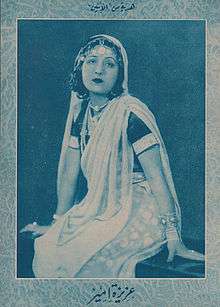Aziza Amir
| Aziza Amir | |
|---|---|
 | |
| Native name | عزيزه امير |
| Born |
Mofeeda Mahmoud Ghoneim December 19, 1901 Damietta, Egypt |
| Died |
February 28, 1952 (aged 50) Cairo, Egypt |
| Nationality | Egyptian |
| Occupation | Actress, screenwriter, producer |
| Children | Amira Amir |
Aziza Amir (Arabic: عزيزة أمير ;17 December 1901 – 28 February 1952) was an Egyptian actress, producer, and screenwriter. She has legendary status in Egyptian film.[1]
Early life and career
Amir got her acting start in the theater. She joined the "Ramsis" acting troupe in 1925. She acted in the theater until 1935, when she decided to focus her attention on films.[2] Amir starred in Laila in 1927; this film was the first full-length feature to come out of Egypt.[1][lower-alpha 1] She would form a production company with director Wadad Orfi.[3] There were disputes while the film was being made and, as a result, Orfi was replaced by Stephane Rosti.[4] Both the media and Amir husband's family at the time of Laila's release opposed her participation in the film; Laila went on to be a success.[2]
In 1933, she wrote, directed, and starred in Pay for your Sins (1933).[lower-alpha 2][5]
Egypt's film industry began to thrive in the 1940s; Amir began to write more screenplays as a result. She would eventually have seventeen writing credits to her name.[5]
Amir had an adopted daughter Amira who acted alongside her in the film My Daughter (1944).[6]
Amir would star and produce a total of twenty five films in her lifetime.[2]
Selected filmography
As actress
- Laila (1927)
- Daughter of the Nile (1929)
- El warsha (1941)
- Ibn al-Balad (1943)
- My Daughter (1944)
- The Magic Hat (1944)
- The Return of the Magic Hat (1946)
- The Unknown Singer (1946)
- Hadaya (1947)
- Above the Clouds (1948)
- Everyone is Singing (1948)
- Nadia (1949)
- Fate and Fortune (1951)
As writer
- The Workshop (1940)
- Ibn al-Balad' (1942)
- The Magic Hat (1944)
- My Daughter (1944)
- Hadaya (1947)
- Above the Clouds (1948)
- A Girl from Palestine (1949)
- My Father Deceived Me (1951)
As producer
- Laila (1927)
- Pay for your Sins (1933)
- Hadaya (1947)
- Everyone Is Singing (1948)
- Above the Clouds (1948)
- My Father Deceived Me (1951)
- Virtue for Sale (1951)
Notes
- ↑ According to Hillauer, there is debate on wither or not Amir directed the film; the credit usually goes to Wadad Orfi. However, Ginsberg and Lippard claim that Amir was the first Egyptian woman to have directed and produced a film.
- ↑ The film's title has several English translations; Atone for your Sins and Pay for your Misdemeanor are the most common.
References
- 1 2 Hillauer, Rebecca (2005). Encyclopedia of Arab Women Filmmakers. Cairo, Egypt: American University in Cairo Press. pp. 28–29. ISBN 9789774162688. Retrieved 20 December 2015.
- 1 2 3 Maleh, Ghassan (1999). World Encyclopedia of Contemporary Theatre Volume 4: The Arab World. London: Routledge. p. 38. ISBN 9780203168042. Retrieved 20 December 2015.
- ↑ Ginsberg, Terri; Lippard, Chris (2010). Historical Dictionary of Middle Eastern Cinema. Lanham: Scarecrow Press. p. xxii. ISBN 9780810873643. Retrieved 20 December 2015.
- ↑ Armes, Roy (2008). Dictionary of African Filmmakers. Bloomington, IN: Indiana University Press. p. 105. ISBN 9780253000422. Retrieved 20 December 2015.
- 1 2 Van Eynde, Koen (2015). Women screenwriters : an international guide. Houndmills, Basingstoke, Hampshire ; New York, NY: Palgrave Macmillan. pp. 28–29. ISBN 9781137312365. Retrieved 20 December 2015.
- ↑ Boraïe, Sherif (2008). سنوات الذهبية في السينما المصرية: سينما كايرو،. Cairo; New York: The American University in Cairo Press. p. 64. ISBN 9789774161735.
External links
- Aziza Amir at the Internet Movie Database
- Aziza Amir in libraries (WorldCat catalog)